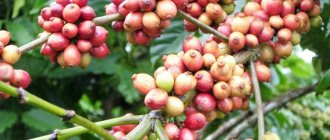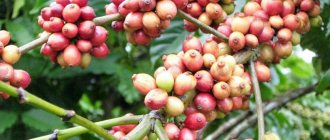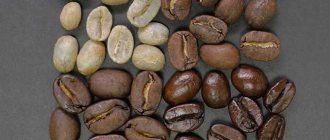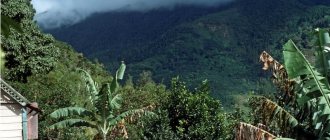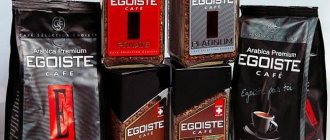Each of us approaches coffee differently. Some people make coffee only on weekends and holidays, some people can’t wake up without coffee and start every morning with a cup of aromatic drink, while for others, coffee is a way of life and they don’t part with a glass of coffee all day long. But everyone is asking one question: how to choose good coffee in a store? I would like to point out right away that there is no clear answer. The same type of coffee can evoke completely different feelings in two people: from delight to complete rejection. Each person has their own taste preferences, habits and sensitivities. For some, it is important that the coffee is first and foremost strong, for others it is light and with notes of honey, while others prefer a soft, balanced and creamy taste. There can be a huge variety of requests, but, fortunately, there are so many varieties of coffee and different blends that you can choose “his” coffee for everyone. So, when choosing a mixture, every nuance matters: the type of coffee and its origin, the composition of the mixture, the degree of roasting, freshness. Knowing these features will help you better navigate the huge variety of blends in the future and find the coffee that’s right for you.
We will not understand the features of each type of coffee. There are a huge number of them and for the average consumer this information is not particularly important. Firstly, because you will need to seriously delve into this topic, read and remember the characteristics of each type of coffee, taste it, compare it with others... But this is not what we want. It is important for us to come to the store and quickly choose the right coffee. Secondly, we will talk about coffee in packs and, basically, manufacturers use mixtures of 2, 3 or 10 different types of coffee to get a certain taste of coffee and they do not indicate the name of the varieties used. You will ask why? More on this later. So we will look at the most obvious and simple details.
Why choose coffee beans?
Of course, an instant drink is much easier and faster to prepare. But real gourmets say that real coffee can only be in beans. And this is true, since for the production of a soluble product they use low-grade raw materials - fragments and fragments of grains, sometimes even affected by weevils. Even the sediment formed during harvesting can be used for production. It is worth knowing that manufacturers, so to speak, “enrich” the drink mixture with all sorts of additives of crushed chicory, oats, barley, and acorns.
Then this whole mass is boiled for three to four hours, after which the same amount is evaporated. Knowing all the production technology, it is easy to understand that there is very little natural coffee in an instant drink. It is for this reason that experts recommend using a drink made from natural grains. Let's now figure out how to choose coffee beans in a store and what you need to know for this.
Reviews from people
Marina, 35 years old:
I've been buying only bean coffee for 5-6 years now. This is very convenient because its aroma lasts much longer than ground. And the taste, in my opinion, is much richer. And with a coffee machine it’s doubly convenient: you throw the beans into it and after 20 minutes you get a wonderful cup of coffee.
Konstantin, 27 years old:
I once tried a friend’s coffee made from beans. And now I can’t tear myself away from him. I specially bought myself a coffee grinder and a Turkish coffee pot and every morning I treat myself to unforgettable coffee, so rich and tart.
Olga, 44 years old:
My husband gave me a coffee machine for my birthday. I tried special capsules for her and ground coffee. But still, the most delicious bean coffee for me is. It tastes so good. And what an aroma when coffee is brewing!
Best coffee
In order to know how to choose coffee beans, you need to navigate its types. There are only two types of beans in the world - Arabica and Robusta, which are radically different from each other. Arabica gives the drink a very refined taste and incredibly refined aroma. These grains are used to make soft, invigorating drinks with a nutty, creamy or chocolate aftertaste. This is the kind of coffee many of us love.
Robusta by itself is not very good. As a rule, it is used to prepare mixtures with Arabica coffee. It gives the drink some bitterness and everyone’s favorite creamy foam. Robusta is not used in its pure form, since the drink it produces is very bitter and strong. It contains three times more caffeine than Arabica. Expensive Robusta varieties have a very specific taste, but there are still people who like it.
All Arabica varieties are much more expensive than Robusta. This is due not only to its taste, but also to the fact that it has lower yield. Its dense grains contain much more aromatic oils, which is why the ripening process takes longer.
Decaf coffee – does it make sense?
This product is chosen by those for whom caffeine is contraindicated for some reason. For example, pregnant women or people with heart disease. During the production of such a product, the beans are washed with a special solution, removing up to 97% of caffeine from them. Then fried and crushed.
The taste and aroma become soft and less pronounced, the finished drink does not have an invigorating effect. However, there are still benefits from it. Some polyphenols and antioxidants are retained even after the decaffeination process. When choosing decaffeinated coffee, it is better to choose the whole bean option.
Light roast
Light roasting has several degrees:
- Scandinavian. The grains are simmered at low temperatures. In this case, the beans do not open, but increase slightly in size. As a result, the grains have an aroma somewhat similar to that of fresh bread. This roast is suitable for Arabica beans from Kenya, Nicaragua and Jamaica.
- American. The grains have a light brown tint, and the drink turns out to be inexpressive in taste.
- Urban. Coffee made from such beans turns out darker, and the taste of the drink is dominated by sourness.
Universal roast
Medium roast, or, as it is also called, universal roast, is the ideal option. This is how grains brought from Ethiopia, Costa Rica, Colombia and Brazil are roasted.
Medium heat treatment also has its own degrees:
- Full urban. This roasting is done until the second pop. During processing, oily droplets appear on the beans. But the drink made from such grains has an amazing aroma and a certain viscousness.
- French, velvet or Viennese. The beans are roasted until dark brown, causing smoke from the burning oils to appear above them. The drink made from such grains is very strong and rich, with a characteristic bitterness.
Processing methods
You can read more in our previous article.
Cutaway coffee berry © Nicolas Rozental
Coffee is actually more than just a bean. It is the seed of the coffee berry, commonly called a "cherry" for its round shape and typical (but not always) bright red color when ripe. But removing the sticky fruit layer is not so easy; special equipment for depulping and subsequent fermentation is often used for this. These processes are called coffee processing, and the processing methods also affect the taste of the coffee. That's why it will be indicated on the coffee pack.
Washed or wet processing
The pulp is removed with water, then the grains are dried. This method does not greatly affect the taste of the coffee, which means you can taste the pure, natural taste of the bean.
Dry or natural method
The beans are slowly dried under the sun while still in the coffee cherry. This method is intended to produce a sweet and fruity taste. But if suddenly the drying is done poorly, the coffee may turn out to be of poor quality and unsatisfactory taste. But, as a result of proper drying, the coffee will be very tasty. It is also an environmentally friendly option.
Honey and half-wash method
Coffee cherries are dried with varying amounts of berry pulp on the coffee bean. The more pulp, the more sweetness and body there will be in the taste.
However, the best way to understand the difference in processing methods is to try it. Get washed and naturally processed coffee from the same region or, better yet, the same farm. Feel these differences for yourself in your cup.
coffee COLUMBIA LA LUNA, washed processing of coffee berries, www.coffeeproject.ru
Deep roast
Strong roasting gives the beans a dark brown hue. The drink made from such grains has a very rich aroma and a noticeable bitterness. Brazilian varieties, Cuban and Guatemalan Robustas and Arabicas are roasted in this way.
There is also a dark roast, it is also called Mexican, Cuban or Spanish. There is practically no water left in the grains after heat treatment. Boba is used to make blends to create a new flavor palette.
But Italian roasting is used to prepare espresso blends. The beans are first deeply fried and then blasted with air. After this, the grains remain open to rest, since carbon dioxide is still actively released from them. The coffee is then packaged in paper bags with foil. It is this packaging that inhibits the oxidation process and allows you to maintain an acceptable level of humidity.
Knowing all the options for processing coffee beans and focusing on your preferences, in the store you will not have a question about which coffee beans to choose.
Blend vs Single Origin
The concept of SINGLE ORIGIN (single origin) means coffee beans collected from one region, one farm, while BLEND is a mixture of different coffee varieties. The term micro lots is used to refer to special varieties of coffee specially grown within a small farm or on a specific area of a plantation.
MICROLOT is one type of grain, collected from one farm, processed in one way. approx. Editorial staff
The question arises: is such a division necessary for the average coffee drinker? Yes, because the taste of coffee is affected by where and in what conditions it is grown. As we will now see, country, region, farm, processing method, variety of coffee tree and much more affect the taste and aroma of our drink.
SINGLE ORIGIN is a coffee bean collected from one farm, processed in one way and roasted according to one profile. Typically, these are high-quality coffees with unique flavor characteristics that roasters do not want to overshadow or mix with other varieties.
BLEND (coffee blend) is created when a mixture of two coffee varieties gives a better taste than the same two varieties separately and in order to achieve taste stability. Let's say there is a light, fruity Ethiopia, but it lacks a little body. (For example, blends are often used to make espresso)
While SINGLE ORIGIN is generally more prized by specialty drinkers (and costs more) than BLEND, they can both be excellent. There are bad SINGLE ORIGIN and good BLEND, they just have different concepts. Try it and don't give up on coffee just because it's a blend of beans from three countries.
At the same time, immerse yourself in the world of SINGLE ORIGIN by tasting coffee from different regions. Take Guatemala, which is known for its acidity, balance and spicy notes, then compare it to coffee from Rwanda, which is known for its sweetness and full body. And then, try samples from two different regions of Colombia - say, Nariño and Santander. Get to know the origins and characteristics of the coffees you love.
But remember, just because a country tends to have a certain flavor of coffee, doesn't mean all of its coffee will match that flavor. Be open to new discoveries!
BREAKFAST BLEND (ESPRESSO MIXTURE of two varieties of Arabica Brazil Fine Cup + Ethiopia Sidamo) www.coffeeproject.ru
Packaging of grains
When you come to the store, having the knowledge of how to choose good coffee beans, you can safely begin to search for a suitable option. The range of goods in supermarkets is quite impressive. What should you pay attention to when making your choice? Of course, on the packaging. It is this that is very important for maintaining the quality of the product.
Currently, there are several packaging options on the coffee market. One of them is paper bags. They are used to pack beans purchased in coffee shops or coffee shops. Purchasing goods in such places is an excellent option, but you should not take more than 200 grams, since grains are stored in such packaging for no more than two weeks. This means it’s always better to take a portion of fresh ones.
Which brand to choose
Almost every year, various culinary publications, retail chains or regulatory organizations compile ratings of the best coffee brands. In my opinion, this exercise is pointless, since “taste and color”, as you know... And the opinion of any of these sources is to a certain extent subjective. Therefore, only you can make your own rating of the best coffee samples for your taste. Based on your experience and taste preferences.
To navigate the abundance of brands represented on the domestic market, you can rely on sales statistics:
- For coffee machines, the brands most often purchased are Julius Meinl, Gaggia, Saeco;
- in grains choose Lavazza, Paulig and Jardin;
- popular instant brands - Egoiste, Carte Noire, Nescafe;
- ground – Living Coffee, Illy, Kimbo.
Vacuum packaging
Vacuum packaging can be made in two versions - cans and pacts. How to choose quality coffee beans if it is already packaged? You should focus specifically on the quality of the packaging material. After all, its main task is to protect the grains from exposure to air. If the beans come into contact with the environment, they will react and lose their original taste.
The most popular is gas-filled packaging with a vent valve, which allows vapors to escape, but at the same time air does not get inside. The valve allows you to feel the aroma of the beans after pressing the pack. In such an airtight package, coffee can be stored for 18 to 24 months. The packs are made of durable material that should not tear at the folds. Sealed bags with valves and jars are used by those companies that value their reputation. Most enterprises package grains in cheaper bags with foil. Now, knowing how to choose packaged coffee beans, you can easily navigate a large assortment of products.
Labels
Good and high-quality packaging is not all that is worth paying attention to. Experts in this matter recommend looking at the label. On it, the manufacturer must indicate the maximum amount of information about the grains, indicating the country of origin, type of grinding and roasting. The degree of grinding can be indicated schematically. The presence of such information allows us to hope that the manufacturer cares about customers and provides information about production technology.
It is also worth paying attention to data on shelf life, packaging and frying. You can recognize low-quality goods by deadlines. If the packaging has a non-return valve, you can smell the grains. If you notice a rancid aroma, you should not take the coffee as it is stale. Knowing how to choose coffee beans, you can approach the purchase thoroughly, paying close attention to all the nuances.
How to choose ground coffee
Many people prefer to buy natural coffee already ground. This saves time and eliminates the need to think about additional equipment such as a coffee grinder or coffee machine. Each grind level has its own purpose:
- coarse grinding is suitable for piston coffee makers; such a drink will have to be infused for at least 10 minutes;
- medium – suitable for geyser and filter coffee makers and is generally quite universal;
- thin – used for espresso coffee machines and also for filter coffee makers;
- ultra-fine - grinding, similar to flour, is produced specifically for Turks.
In my opinion, ground coffee has two disadvantages. Firstly, after opening the package, it quickly loses its aroma and taste. Secondly, some manufacturers sin by adding flavorings to it, and not always natural ones. Therefore, if you have opted for ground coffee, buy packages of the minimum volume. And carefully read the label information about additives.
Appearance of grains
How to choose the right coffee beans if you buy them by weight? In this case, it is worth paying attention to the appearance of the grains. Let us remember that Arabica and Robusta differ even in appearance. Their beans not only have different sizes, but also different shapes. Arabica beans vary in size between 5-8 millimeters. Large beans of this type are an indicator of excellent quality. But even here there are exceptions. For example, there are species that have excellent characteristics, but are modest in size (Yemen Arabica).
How to choose coffee beans based on appearance? In any mixture, all the beans should be approximately the same size and have the same shape. If you see that the grains have differences, then there is a high degree of probability that cheaper robusta was added to the mass.
Good coffee should have the correct shape of the beans, which even feel velvety to the touch. All beans in the mixture should be the same color. The presence of pieces of grains and stains on them is not allowed. All these flaws indicate low quality.
Only melange mixtures can contain beans that differ in color, since they contain types with different degrees of roasting.
Another indicator of quality is the aroma of the coffee. Good grains have a strong aroma, without burnt or rotten impurities. Beans that have long expired have a rancid smell.
Variety and grade
You can read more in our previous article.
Not all coffee trees are the same. The type and variety can have a significant impact on the final flavor of the cup, so let's take a look at the common varieties.
Specialty coffee
As a rule, this is Arabica , known for its aroma and delicious taste. Robusta is another common species; it has a stronger taste and contains significantly more caffeine. From time to time you may come across a less common species - Liberica .
Next come the varieties of Arabica : Caturra, Catuai, Typica, Geisha, Pacamara, Maragogipe...and many others. Bourbon tends to be sweet. Geisha typically has a light, tea-like body, a jasmine aroma and a complex, unique flavor.
Once you can feel the impact of processing on the taste of the cup, it's time to start understanding the varieties and varieties. Try washed Bourbon and Caturra from El Salvador. Then compare them to natural Bourbon from Rwanda. The beauty of specialty coffee is that each variety is truly unique. There are so many factors that influence the taste of a cup, and we as consumers can enjoy and appreciate each of them.
Freshly roasted coffee ©Nicolas Rozental
Cost of coffee
Which inexpensive good coffee beans should you choose? Any barista will tell you that in this case it is not worth saving. The higher the price, the better quality drink you will get. This statement clearly applies to elite species. Good coffee can't be cheap. Rather, on the contrary, the low cost should raise doubts about the origin of such grains. The most avid coffee lovers prefer elite varieties.
However, ordinary people, as a rule, pay attention to a product of average cost. In this price category you can also find quite decent coffee. Any barista recommends purchasing beans from a specialty store. Of course, this is not a guarantee that you will not come across a low-quality product, but still, in such places, sellers can help in choosing.
In addition, in such places the coffee does not come into contact with foreign goods, the odors of which can negatively affect the aroma of the coffee. In specialized places you will be offered a larger selection of mixtures and varieties. In addition, you will have the opportunity to visually look at the beans and smell their aroma. To prepare a quality drink, you need freshly roasted coffee, which has been stored in accordance with the standards. In supermarkets, they do not pay attention to this fact, and in specialized outlets the beans are stored in containers that allow them to preserve all their properties.
A little history of coffee beans in Russia
In the middle of the 17th century, coffee began to appear in Russia, but only as a medicine. At that time, Tsar Alexei Mikhailovich was treated with an exotic drink for headaches, runny nose and ailments. At the beginning of the 18th century, the great reformer, Tsar Peter the Great, popularized the drink, despite the protests of the Old Believers.
In the 19th century, coffee mania swept St. Petersburg, and by the beginning of the 20th century, gradually the whole country. By the end of the last century, Russia was among the ten countries with the highest coffee consumption in the world. It was then that the possibilities for choice appeared.
Coffee for Turkish
How to choose Turkish coffee beans? It is worth paying attention to the grinding of coffee beans. Turkish coffee needs to be ground into dust. Not every professional coffee grinder, let alone a home one, copes with this task. The finer the grind, the greater the degree of solubility of substances inside the coffee, which means the more aromatic and stronger the drink will be. The cooking process in a Turk takes literally a couple of minutes. During this time, the substances should have time to dissolve and give off taste and aroma. This effect cannot be achieved using coarsely ground coffee.
